Abstract
Lever pressing by two squirrel monkeys was maintained under a variable-interval 60-second schedule of food presentation. When response-dependent electric shock was made contingent on comparatively long interresponse times, response rate increased, and further increases were obtained when the minimum interresponse-time requirement was decreased. When an equal proportion of responses produced shock without regard to interresponse time, rates decreased. Thus, shock contingent on long interresponse times selectively decreased the relative frequency of those interresponse times, and increased the relative frequency of shorter interresponse times, whereas shock delivered independent of interresponse times decreased the relative frequency of shorter interresponse times while increasing the frequency of longer ones. The results provide preliminary evidence that interresponse times may be differentiated by punishment, further supporting the notion that interresponse times may be considered functional units of behavior.
Keywords: interresponse times, punishment, response-contingent electric shock, molecular analyses, squirrel monkey
Full text
PDF
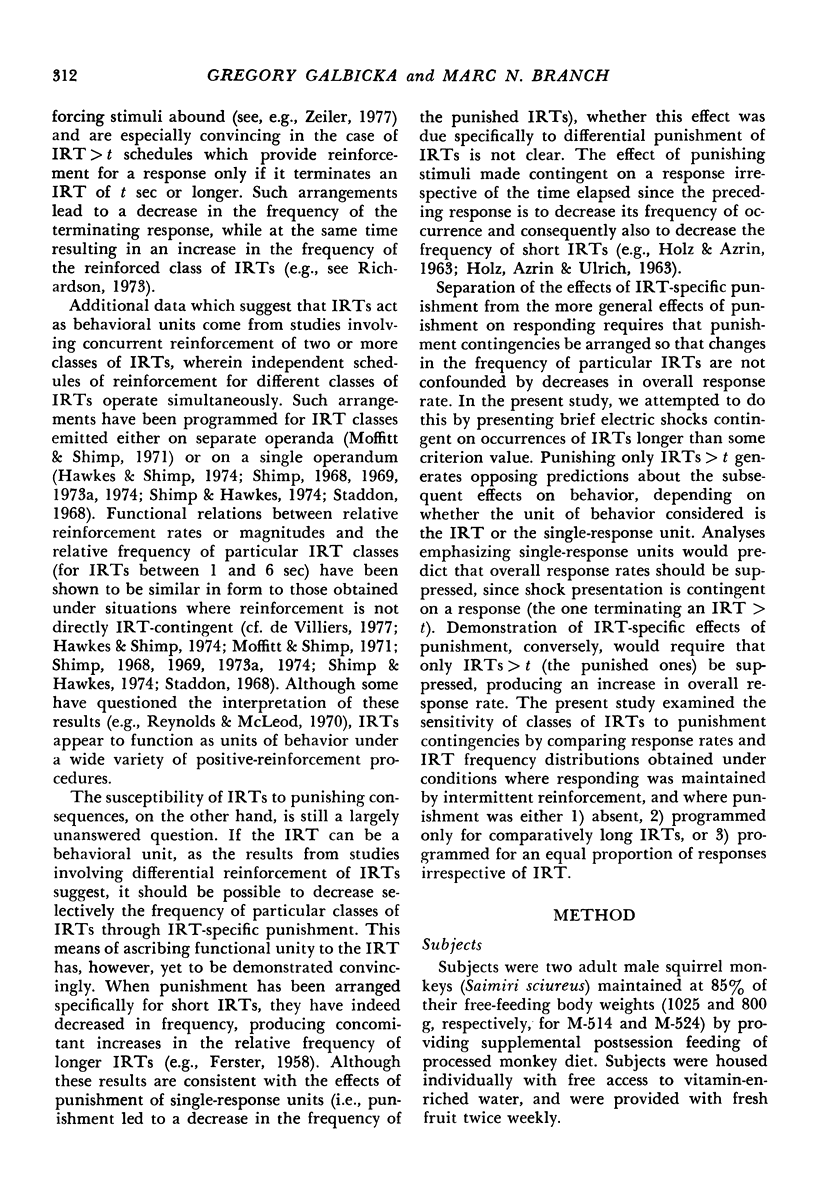
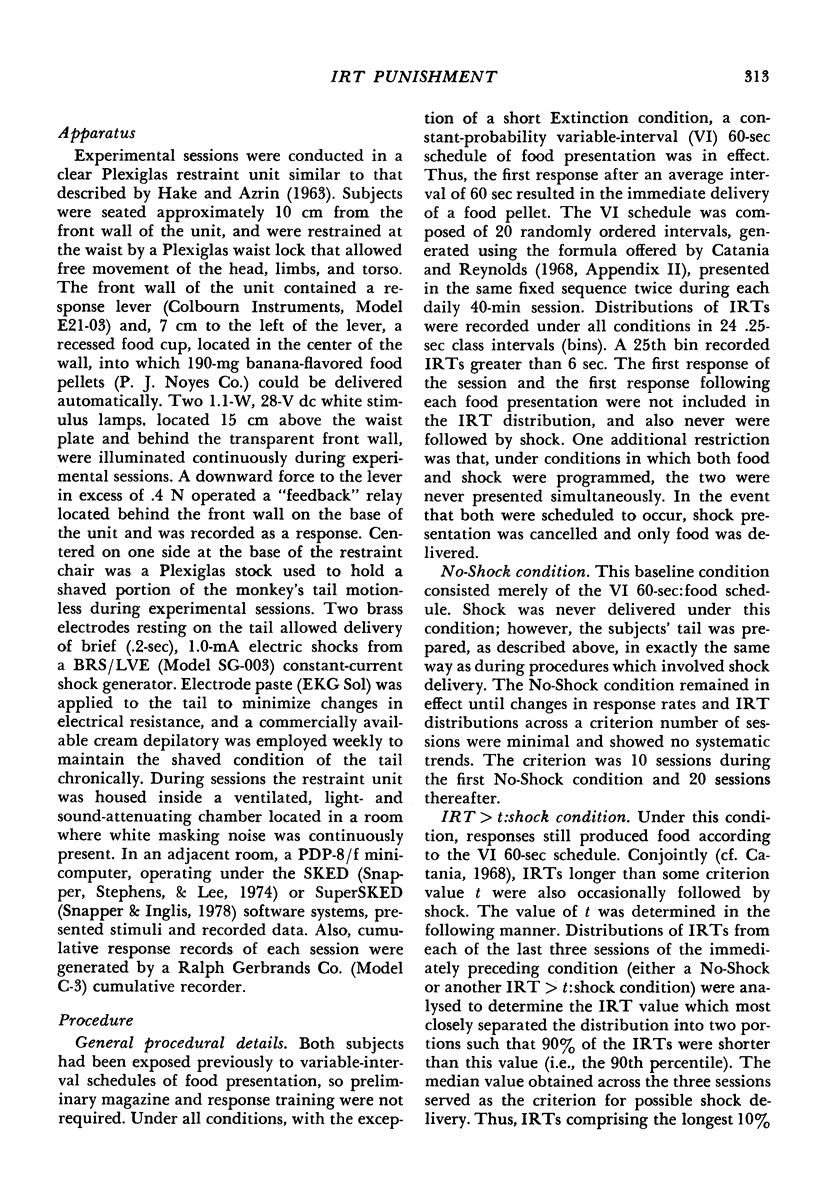

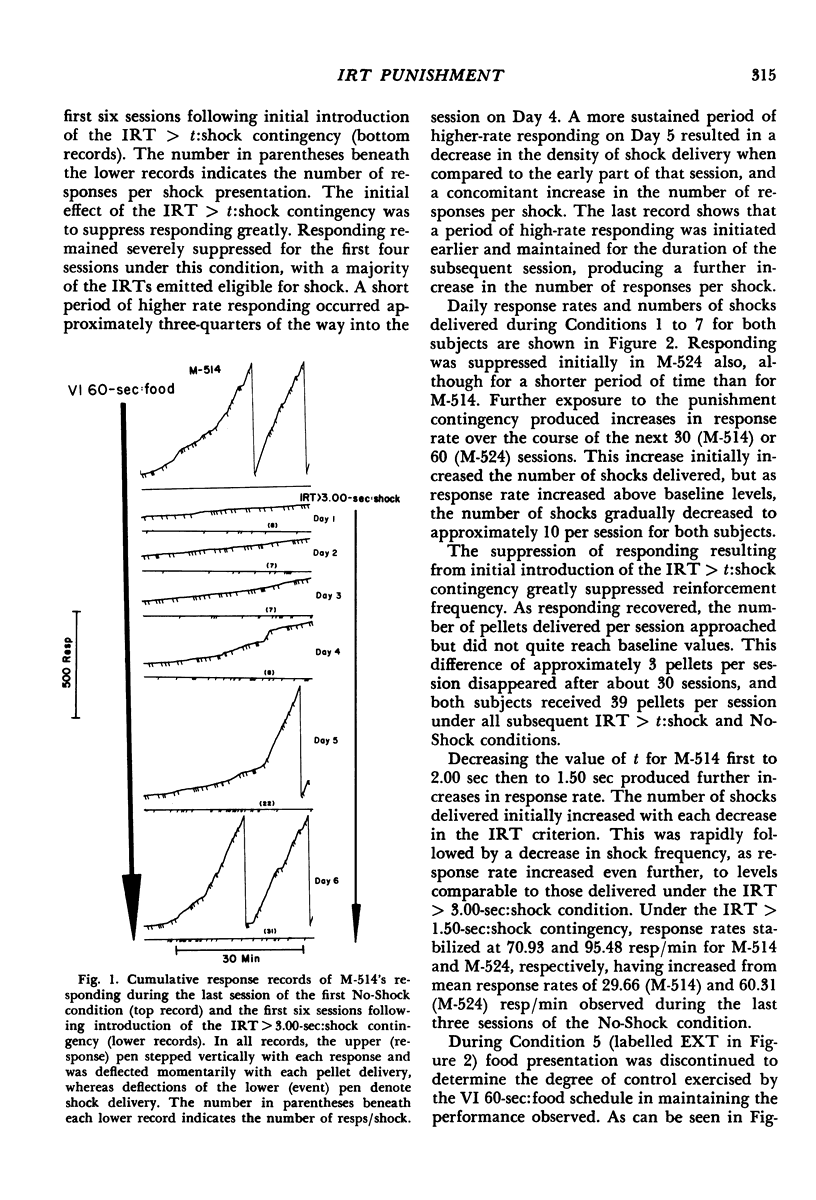
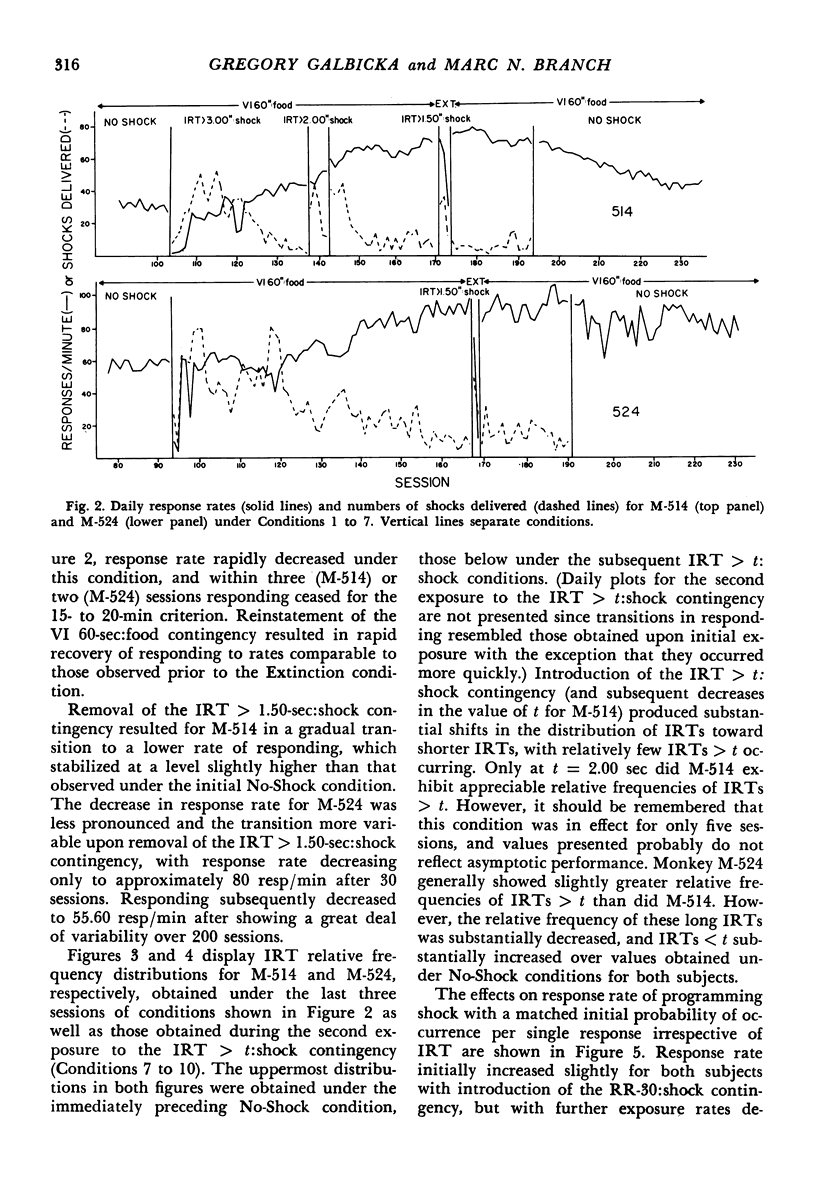


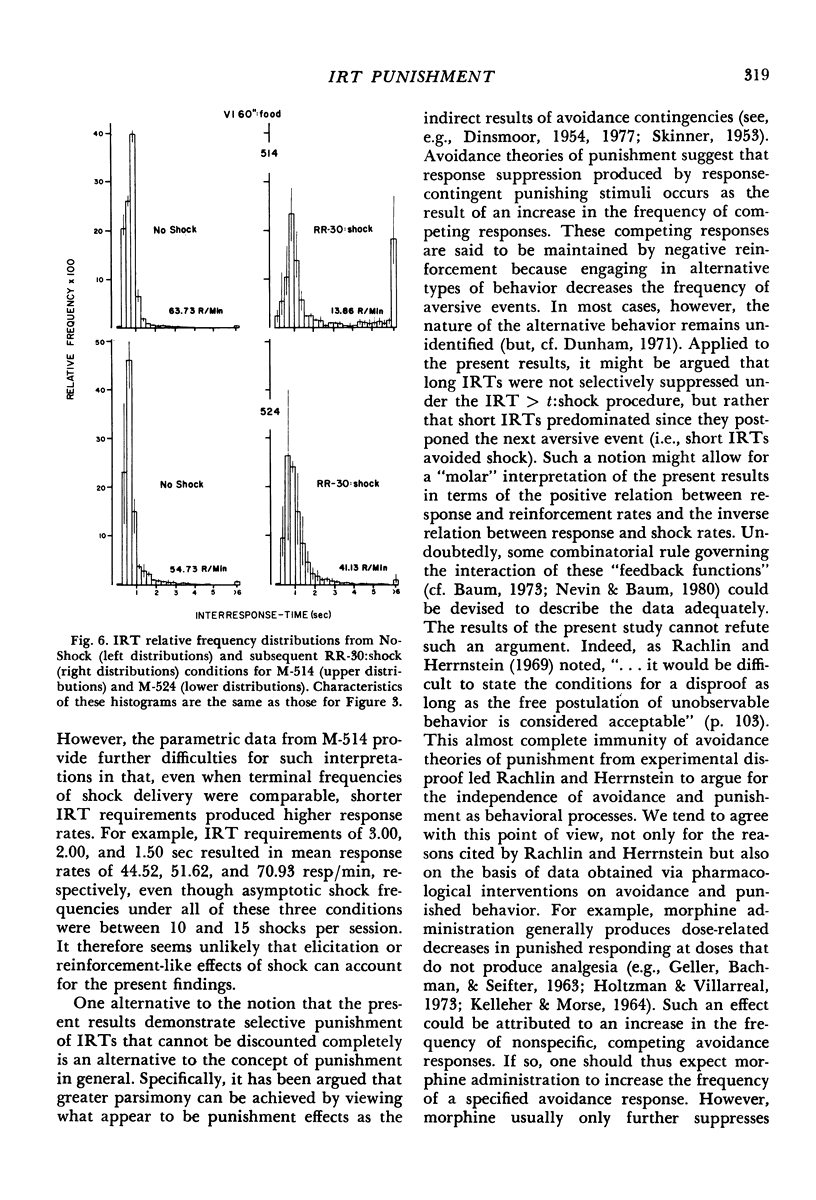
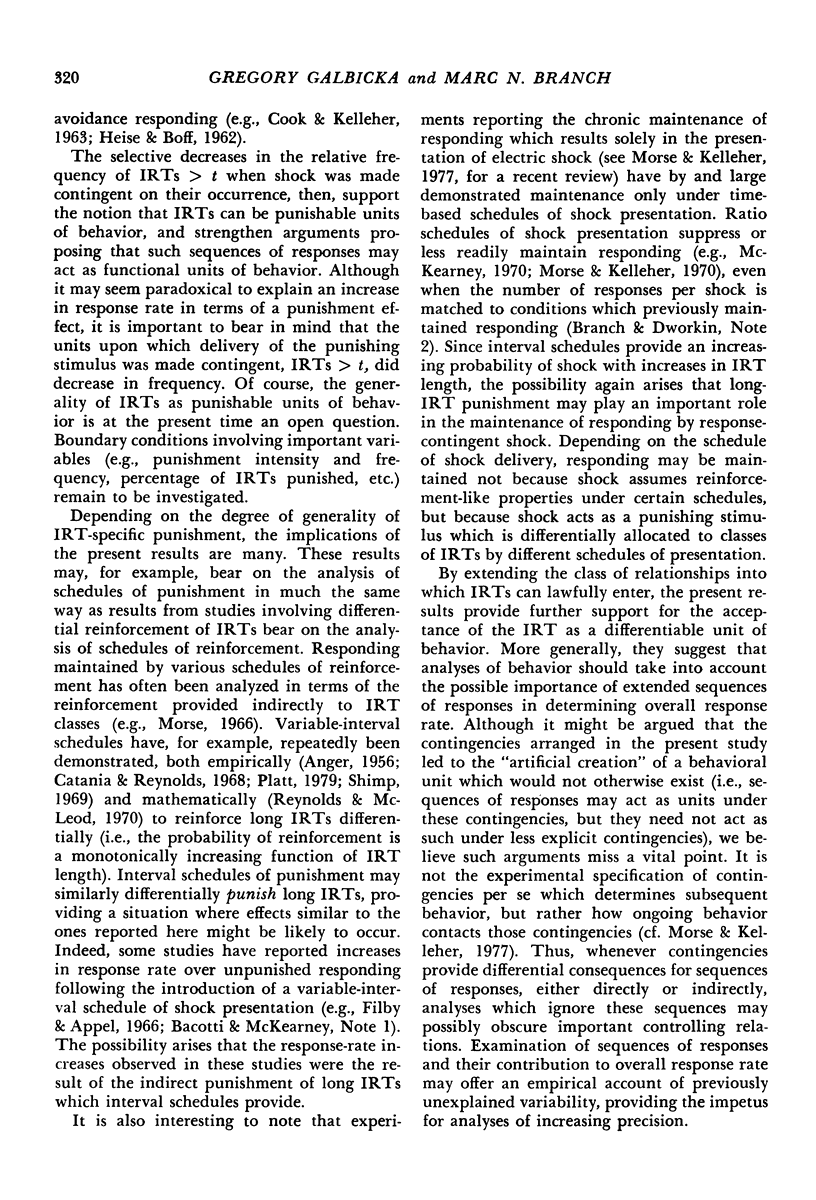
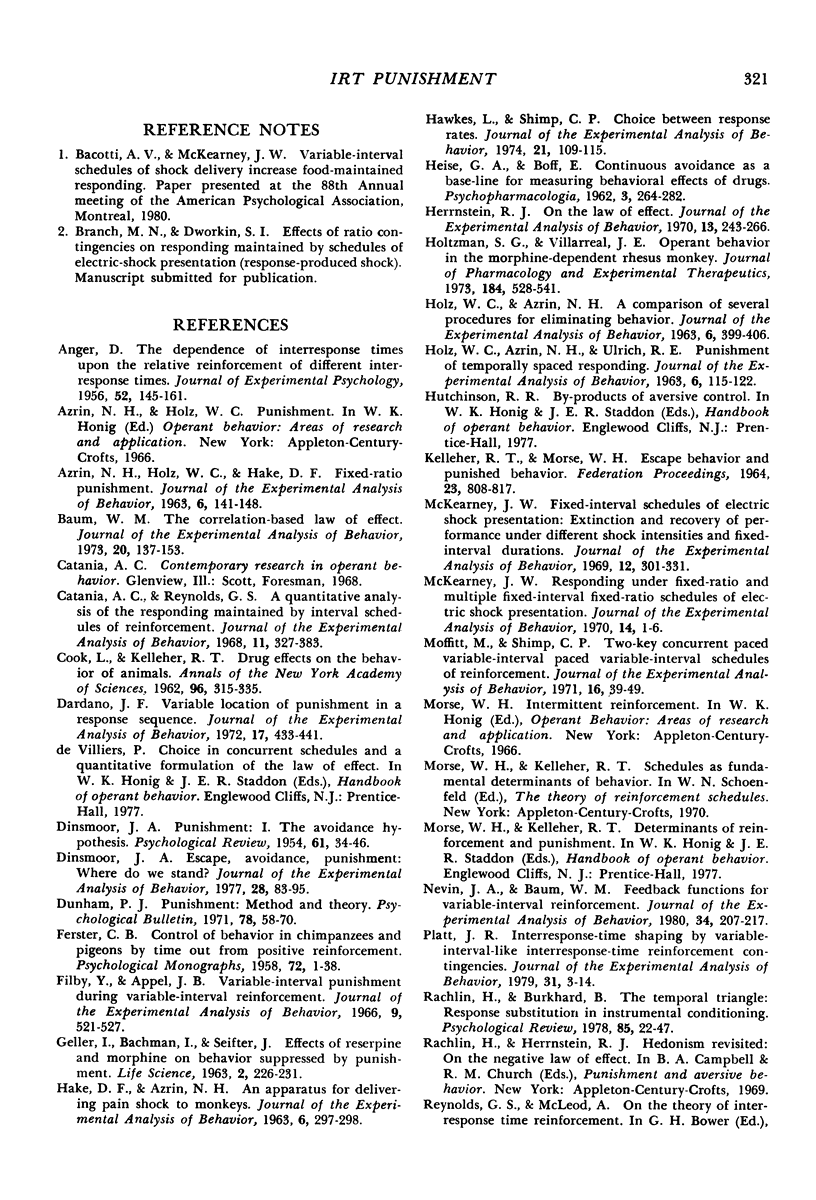

Selected References
These references are in PubMed. This may not be the complete list of references from this article.
- ANGER D. The dependence of interresponse times upon the relative reinforcement of different interresponse times. J Exp Psychol. 1956 Sep;52(3):145–161. doi: 10.1037/h0041255. [DOI] [PubMed] [Google Scholar]
- AZRIN N. H., HOLZ W. C., HAKE D. F. Fixed-ratio punishment. J Exp Anal Behav. 1963 Apr;6:141–148. doi: 10.1901/jeab.1963.6-141. [DOI] [PMC free article] [PubMed] [Google Scholar]
- Baum W. M. The correlation-based law of effect. J Exp Anal Behav. 1973 Jul;20(1):137–153. doi: 10.1901/jeab.1973.20-137. [DOI] [PMC free article] [PubMed] [Google Scholar]
- Catania A. C., Reynolds G. S. A quantitative analysis of the responding maintained by interval schedules of reinforcement. J Exp Anal Behav. 1968 May;11(3 Suppl):327–383. doi: 10.1901/jeab.1968.11-s327. [DOI] [PMC free article] [PubMed] [Google Scholar]
- DINSMOOR J. A. Punishment. I. The avoidance hypothesis. Psychol Rev. 1954 Jan;61(1):34–46. doi: 10.1037/h0062725. [DOI] [PubMed] [Google Scholar]
- Dardano J. F. Variable location of punishment in a response sequence. J Exp Anal Behav. 1972 May;17(3):433–441. doi: 10.1901/jeab.1972.17-433. [DOI] [PMC free article] [PubMed] [Google Scholar]
- Dinsmoor J. A. Escape, avoidance, punishment: where do we stand? J Exp Anal Behav. 1977 Jul;28(1):83–95. doi: 10.1901/jeab.1977.28-83. [DOI] [PMC free article] [PubMed] [Google Scholar]
- Filby Y., Appel J. B. Variable-interval punishment during variable-interval reinforcement. J Exp Anal Behav. 1966 Sep;9(5):521–527. doi: 10.1901/jeab.1966.9-521. [DOI] [PMC free article] [PubMed] [Google Scholar]
- GELLER I., BACHMAN E., SEIETER J. Effects of reserpine and morphine on behavior suppressed by punishment. Life Sci. 1963 Apr;4:226–231. doi: 10.1016/0024-3205(63)90002-x. [DOI] [PubMed] [Google Scholar]
- HAKE D. F., AZRIN N. H. An apparatus for delivering pain shock to monkevs. J Exp Anal Behav. 1963 Apr;6:297–298. doi: 10.1901/jeab.1963.6-297. [DOI] [PMC free article] [PubMed] [Google Scholar]
- HEISE G. A., BOFF E. Continuous avoidance as a base-line for measuring behavioral effects of drugs. Psychopharmacologia. 1962 Oct 5;3:264–282. doi: 10.1007/BF00411367. [DOI] [PubMed] [Google Scholar]
- HOLZ W. C., AZRIN N. H. A comparison of several procedures for eliminating behavior. J Exp Anal Behav. 1963 Jul;6:399–406. doi: 10.1901/jeab.1963.6-399. [DOI] [PMC free article] [PubMed] [Google Scholar]
- HOLZ W. C., AZRIN N. H., ULRICH R. E. Punishment of temporally spaced responding. J Exp Anal Behav. 1963 Jan;6:115–122. doi: 10.1901/jeab.1963.6-115. [DOI] [PMC free article] [PubMed] [Google Scholar]
- Hawkes L., Shimp C. P. Choice between response rates. J Exp Anal Behav. 1974 Jan;21(1):109–115. doi: 10.1901/jeab.1974.21-109. [DOI] [PMC free article] [PubMed] [Google Scholar]
- Herrnstein R. J. On the law of effect. J Exp Anal Behav. 1970 Mar;13(2):243–266. doi: 10.1901/jeab.1970.13-243. [DOI] [PMC free article] [PubMed] [Google Scholar]
- Holtzman S. G., Villarreal J. E. Operant behavior in the morphine-dependent rhesus monkey. J Pharmacol Exp Ther. 1973 Mar;184(3):528–541. [PubMed] [Google Scholar]
- KELLEHER R. T., MORSE W. H. ESCAPE BEHAVIOR AND PUNISHED BEHAVIOR. Fed Proc. 1964 Jul-Aug;23:808–817. [PubMed] [Google Scholar]
- McKearney J. W. Fixed-interval schedules of electric shock presentation: extinction and recovery of performance under different shock intensities and fixed-interval durations. J Exp Anal Behav. 1969 Mar;12(2):301–313. doi: 10.1901/jeab.1969.12-301. [DOI] [PMC free article] [PubMed] [Google Scholar]
- McKearney J. W. Responding under fixed-ratio and multiple fixed-interval fixed-ratio schedules of electric shock presentation. J Exp Anal Behav. 1970 Jul;14(1):1–6. doi: 10.1901/jeab.1970.14-1. [DOI] [PMC free article] [PubMed] [Google Scholar]
- Moffitt M., Shimp C. P. Two-key concurrent paced variable-interval paced variable-interval schedules of reinforcement. J Exp Anal Behav. 1971 Jul;16(1):39–49. doi: 10.1901/jeab.1971.16-39. [DOI] [PMC free article] [PubMed] [Google Scholar]
- Nevin J. A., Baum W. M. Feedback functions for variable-interval reinforcement. J Exp Anal Behav. 1980 Sep;34(2):207–217. doi: 10.1901/jeab.1980.34-207. [DOI] [PMC free article] [PubMed] [Google Scholar]
- Platt J. R. Interresponse-time shaping by variable-interval-like interresponse-time reinforcement contingencies. J Exp Anal Behav. 1979 Jan;31(1):3–14. doi: 10.1901/jeab.1979.31-3. [DOI] [PMC free article] [PubMed] [Google Scholar]
- Richardson W. K. A test of the effectiveness of the differential-reinforcement-of-low-rate schedule. J Exp Anal Behav. 1973 Nov;20(3):385–391. doi: 10.1901/jeab.1973.20-385. [DOI] [PMC free article] [PubMed] [Google Scholar]
- Shimp C. P., Hawkes L. Time-allocation, matching, and contrast. J Exp Anal Behav. 1974 Jul;22(1):1–10. doi: 10.1901/jeab.1974.22-1. [DOI] [PMC free article] [PubMed] [Google Scholar]
- Shimp C. P. Magnitude and frequency of reinforcement and frequencies of interresponse times. J Exp Anal Behav. 1968 Sep;11(5):525–535. doi: 10.1901/jeab.1968.11-525. [DOI] [PMC free article] [PubMed] [Google Scholar]
- Shimp C. P. Probabilistically reinforced choice behavior in pigeons. J Exp Anal Behav. 1966 Jul;9(4):443–455. doi: 10.1901/jeab.1966.9-443. [DOI] [PMC free article] [PubMed] [Google Scholar]
- Shimp C. P. The concurrent reinforcement of two interresponse times: the relative frequency of an interresponse time equals its relative harmonic length. J Exp Anal Behav. 1969 May;12(3):403–411. doi: 10.1901/jeab.1969.12-403. [DOI] [PMC free article] [PubMed] [Google Scholar]
- Shimp C. P. Time allocation and response rate. J Exp Anal Behav. 1974 May;21(3):491–499. doi: 10.1901/jeab.1974.21-491. [DOI] [PMC free article] [PubMed] [Google Scholar]
- Silberberg A., Williams D. R. Choice behavior on discrete trials: a demonstration of the occurrence of a response strategy. J Exp Anal Behav. 1974 Mar;21(2):315–322. doi: 10.1901/jeab.1974.21-315. [DOI] [PMC free article] [PubMed] [Google Scholar]
- Staddon J. E. Spaced responding and choice: a preliminary analysis. J Exp Anal Behav. 1968 Nov;11(6):669–682. doi: 10.1901/jeab.1968.11-669. [DOI] [PMC free article] [PubMed] [Google Scholar]
- Williams D. R. The structure of response rate. J Exp Anal Behav. 1968 May;11(3):251–258. doi: 10.1901/jeab.1968.11-251. [DOI] [PMC free article] [PubMed] [Google Scholar]


